Make your own fruit chutney using seasonal fruits and spices to preserve summer and autumn fruits using this easy chutney recipe. This sweet homemade chutney pairs well with cheeses and curries, makes a tasty sandwich filling and is a perfect way to preserve a glut of fruit.
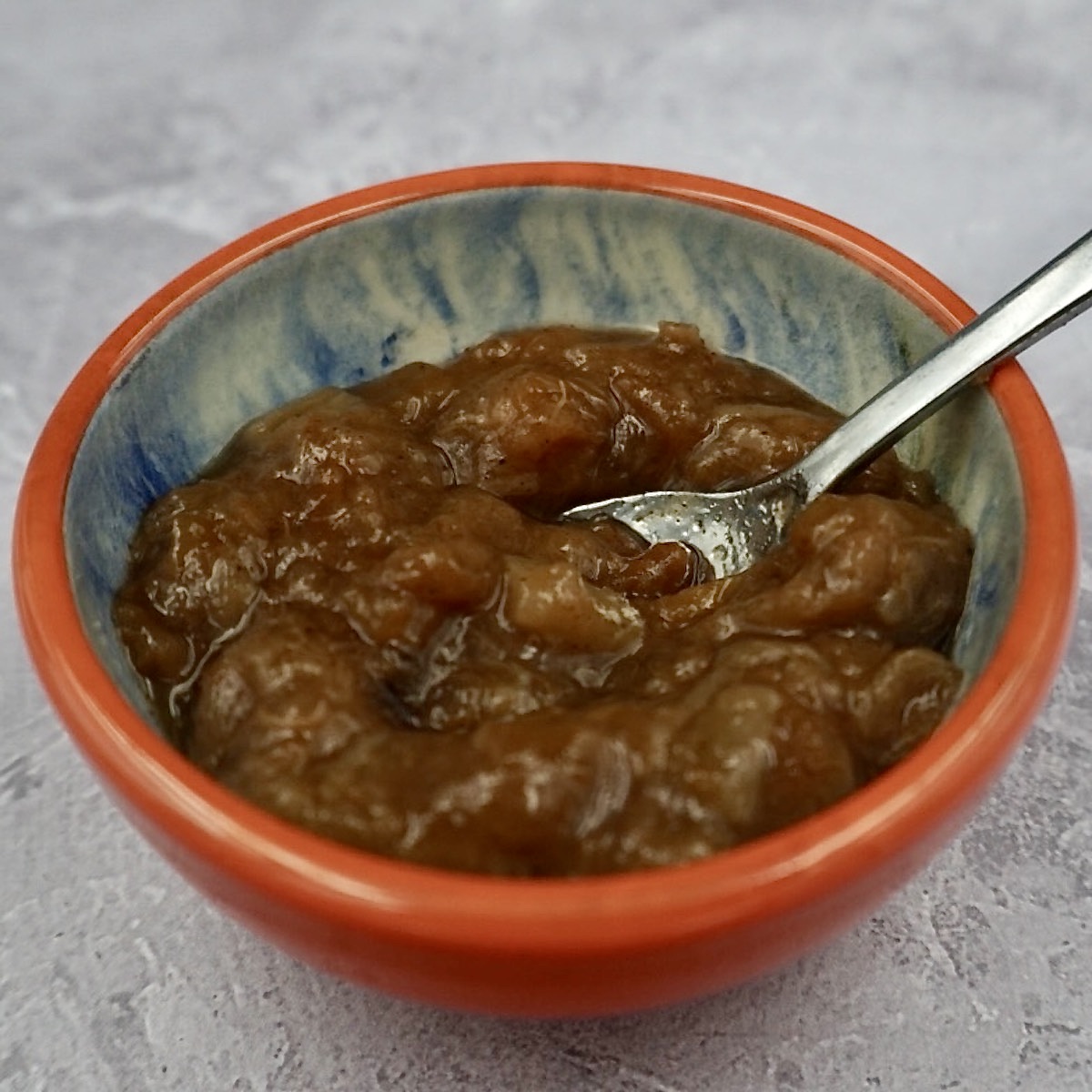
It is a perfect way to use up ripe summer fruits such as peaches, plums, gooseberries or rhubarb or autumn fruits such as apples, pears or figs. Use any combination of fruits to stock your cupboards with this tasty homemade preserve.
Why you'll love this recipe
- It is a great way to use a glut of fruits.
- This versatile recipe can be made using a wide variety of fruits to make use of what you have.
- This homemade preserve is suitable for long storage and will last months or even years.
- This easy chutney recipe has no complicated steps, simply prepare the ingredients, place in a pan and cook.
- It makes a useful homemade gift.
You don't need to go out and buy jars, you can sterilise jam jars which have been used before to fill with your homemade chutney.
If you are looking for other easy chutney recipes you may also like to try this recipe for tomato chutney which is made using ripe red tomatoes, tomato and chilli chutney which a little more heat, use some dried apricots to make this spiced apricot chutney, sweet red pepper chutney or make some caramelised onion chutney using sweet red onions.
The quantities in this easy recipe will make approximately 4 to 6 small to medium jars of chutney.
Chutney ingredients
- Mixed fruits - such as plums, apples, rhubarb, gooseberries, peaches, figs, etc.
- Ground spices such as ginger, mixed spice and allspice - to complement the flavours of the fruits and will add warmth and sweetness to the chutney. You can blend your own spices using this recipe for mixed spice.
- Salt - salt will help preserve your homemade chutney.
- Sugar - here I have used granulated sugar but you could substitute demerara sugar or muscovado sugar if you prefer.
- Vinegar - vinegar is a key ingredient in chutney. It will help preserve the other chutney ingredients and will add to the flavour.
Prepare the chutney fruit
Prepare the fruit by peeling, removing any stones, seeds, etc as follows:
- Plums - remove the peel and stones and cut into pieces.
- Apples - peel, core and dice. Apples are useful to use in addition to other fruits but I suggest you use only a small proportion of apples as they contain a lot of water and too many will make the chutney thin and watery.
- Rhubarb - trim the leaves from the stalks, wash and cut into chunks. If the rhubarb is young and tender the skin can be left but if it is not so fresh you could remove the peel.
- Peaches - peel, remove the stones and cut into pieces.
- Gooseberries - wash, top and tail and cut each gooseberry in half.
- Figs - cut in half and scoop out the centre of the fruit to add to the other ingredients.
How to make fruit chutney
Simply place the ingredients in a large pan and cook until the fruit is soft and the liquid has reduced.
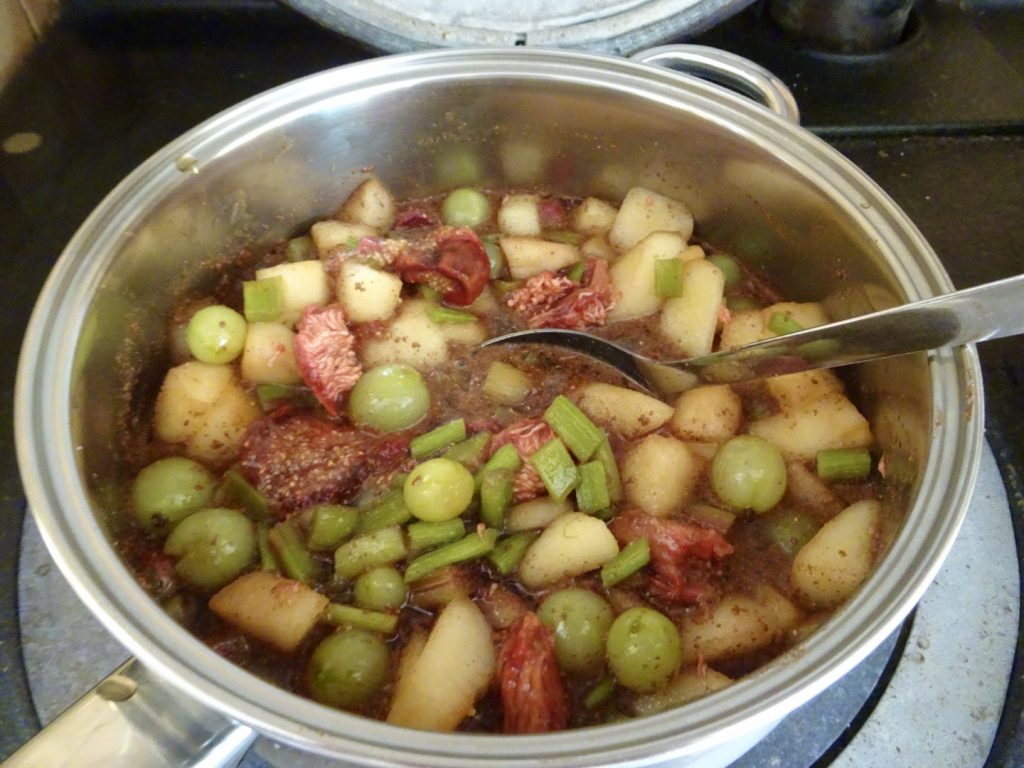
Prepare the jars while the fruit is cooking.
Transfer the mixture into the sterilised jars. Start by filling any larger jars, leaving any smaller jars to the end as your aim is to completely fill any jars you use. Partly filled jars will contain more air and may not keep as well as full jars. If you see any air pockets place a knife into the mixture to remove the pocket of air. Screw the caps onto the jars and leave your jars of chutney to cool. Clean any runs from the outsides of the jars or lids.
How to store chutney
Store in a dark place such as in a box or in the back of a cupboard for a minimum of 8 weeks before eating.
How to serve fruit chutney
- Fruit chutney is a tasty accompaniment to cheeses.
- Add to sandwich fillings and burger toppings.
- Serve with salads.
- It is also a tasty relish to serve alongside nut roast, nut cutlets or falafel.

Tips
- The exact quantity of chutney produced will vary depending on the types of fruit used and how much water the fruits contain. So, it will be difficult to know exactly how many jars will be needed but it is a good idea to prepare more jars than are likely to be filled to be on the safe side.
- As the jars will need to be filled to the top, it is a good idea to prepare jars of different sizes to make it easier to completely fill each jar.
- You may find it easier to fill the jars using a funnel. Alternatively you could use a spoon which is small enough to fit into the jars but this may take longer.
FAQs
Yes, fresh fruit which has been frozen can be used to make this chutney. I often prepare and freeze small quantities of fruit as they are picked and make a batch of chutney when I have enough fruit for this recipe.
Chutney should be stored for a minimum of eight weeks before eating to give the flavours a chance to mature. If you try it too soon the flavours will be too harsh. In my experience the flavours continue to improve over the months.
No, unlike many store bought chutneys this homemade chutney does not need to be refrigerated. It can be stored at room temperature, ideally in a dark place such as in kitchen cupboard or in a box if your cupboards are full. Cooking the fruit in vinegar, sugar and salt will preserve the fruits. So long as the jars are in a good condition, adequately sterilised, and the jars filled without air pockets the chutney will keep for several months or even years.
Other homemade chutney recipes
- Easy red tomato chutney1 Hours 30 Minutes
- Red onion chutney (onion relish)1 Hours 40 Minutes
- Apricot chutney1 Hours
- Tomato and chilli chutney1 Hours 30 Minutes
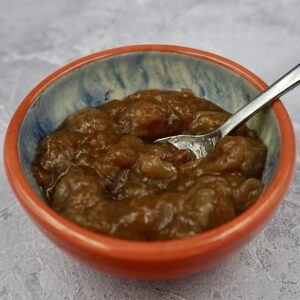

Fruit chutney
Ingredients
- 3.5 kg mixed fruits
- 3 teaspoon ground ginger or mixed spice
- 2 teaspoon ground allspice
- 2 teaspoon salt
- ½ kg granulated sugar
- 600 ml vinegar
Instructions
- Prepare the fruit by peeling and removing any stones, seeds, etc. Cut into chunks and place in a large saucepan.
- Add the vinegar, sugar, spices and salt and stir.
- Bring to the boil and simmer without a lid until the fruit has softened and the liquid has reduced. This may take anything from about half an hour to over an hour depending on the selection of fruits. Some fruits such as apples will have more liquid and will take longer to reduce.
- While the chutney is cooking, place the jars and lids (lids removed) on a baking tray and place in the oven set at a low temperature for about 10 minutes to sterilise.
- Pack the hot chutney into the hot jars to just below the tops making sure there are no air pockets. Pierce any air pockets with a clean knife. Screw the lids onto the jars and leave to cool.
- Store in a cool, dry place such as in the back of a cupboard for a minimum of 8 weeks before using to allow the flavours to mature.
Notes
- Store in a dark place such as in a box or in the back of a cupboard for a minimum of 8 weeks before eating.
- This fruit chutney does not need to be kept in the fridge. So long as it is stored in properly sterilised jars it will keep for at least several months.

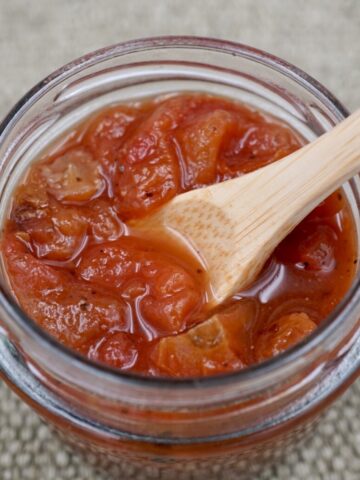






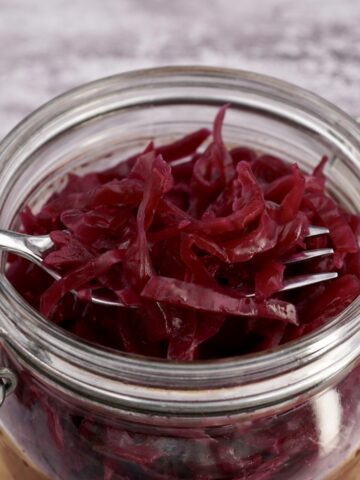
Leave a Reply